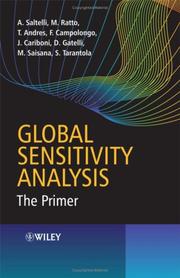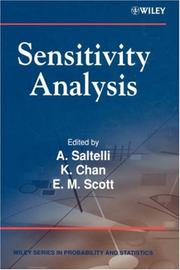| Listing 1 - 5 of 5 |
Sort by
|

ISBN: 9780470059975 0470059974 Year: 2008 Publisher: Chichester, England : John Wiley,
Abstract | Keywords | Export | Availability | Bookmark
 Loading...
Loading...Choose an application
- Reference Manager
- EndNote
- RefWorks (Direct export to RefWorks)
"Mathematical models are good at mapping assumptions into inferences. A modeller makes assumptions about laws pertaining to the system, about its status and a plethora of other, often arcane, system variables and internal model settings. To what extent can we rely on the model-based inference when most of these assumptions are fraught with uncertainties? Global Sensitivity Analysis offers an accessible treatment of such problems via quantitative sensitivity analysis, beginning with the first principles and guiding the reader through the full range of recommended practices with a rich set of solved exercises. The text explains the motivation for sensitivity analysis, reviews the required statistical concepts, and provides a guide for potential applications." "Postgraduate students and practitioners in a wide range of subjects, including statistics, mathematics, engineering, physics, chemistry, environmental sciences, biology, toxicology, actuarial sciences, and econometrics will find much of use here. This book will prove equally valuable to engineers working on risk analysis and to financial analysts concerned with pricing and hedging."--Jacket.
Sensitivity theory (Mathematics) --- Global analysis (Mathematics) --- Mathematical models. --- Basic Sciences. Mathematics --- Mathematical Models, Simulation Models --- Sensitivity theory (Mathematics). --- Global analysis (Mathematics). --- Mathematical Models, Simulation Models. --- Statistique mathématique --- Mathematical statistics --- Mathematical models --- Models, Mathematical --- Simulation methods --- Analysis, Global (Mathematics) --- Differential topology --- Functions of complex variables --- Geometry, Algebraic --- Sensitivity (Mathematics) --- System sensitivity theory (Mathematics) --- Control theory --- wiskundige modellen --- mathematical models --- gevoeligheidsanalyse --- sensitivity analysis --- Wiskundige modellen, simulatiemodellen --- 681.3*F41 --- 681.3*F41 Mathematical logic: computability theory; computational logic; lambda calculus; logic programming; mechanical theorem proving; model theory; proof theory;recursive function theory--See also {681.3*F11}; {681.3*I22}; {681.3*I23} --- Mathematical logic: computability theory; computational logic; lambda calculus; logic programming; mechanical theorem proving; model theory; proof theory;recursive function theory--See also {681.3*F11}; {681.3*I22}; {681.3*I23} --- Statistique mathématique

ISBN: 0471998923 Year: 2000 Publisher: Chichester Wiley
Abstract | Keywords | Export | Availability | Bookmark
 Loading...
Loading...Choose an application
- Reference Manager
- EndNote
- RefWorks (Direct export to RefWorks)
Sensitivity theory (Mathematics) --- Basic Sciences. Statistics --- Statistical methods. --- Statistics (General) --- Statistics (General). --- 511.8 --- 305.970 --- AA / International- internationaal --- Sensitivity (Mathematics) --- System sensitivity theory (Mathematics) --- Statistical methods --- Algemeenheden: Autoregression and moving average representation. ARIMA. ARMAX. Lagrange multiplier. Wald. Function (mis) specification. Autocorrelation. Homoscedasticity. Heteroscedasticity. ARCH. GARCH. Integration and co-integration. Unit roots --- Control theory

ISBN: 9780470870938 0470870931 Year: 2004 Publisher: Hoboken, N.J. Wiley
Abstract | Keywords | Export | Availability | Bookmark
 Loading...
Loading...Choose an application
- Reference Manager
- EndNote
- RefWorks (Direct export to RefWorks)
Sensitivity analysis should be considered a pre-requisite for statistical model building in any scientific discipline where modelling takes place. For a non-expert, choosing the method of analysis for their model is complex, and depends on a number of factors. This_ book guides the non-expert through their problem in order to enable them to choose and apply the most appropriate method. It offers a review of the state-of-the-art in sensitivity analysis, and is suitable for a wide range of practitioners. It is focussed on the use of SIMLAB & a widely distributed freely-available sensitivity analysis software package developed by the authors & for solving problems in sensitivity analysis of statistical models. Other key features: Provides an accessible overview of the current most widely used methods for sensitivity analysis. Opens with a detailed worked example to explain the motivation behind the book. Includes a range of examples to help illustrate the concepts discussed. Focuses on implementation of the methods in the software SIMLAB - a freely-available sensitivity analysis software package developed by the authors. Contains a large number of references to sources for further reading.
Sensitivity theory (Mathematics) --- SIMLAB --- SIMLAB. --- Simulation methods. --- Mathematical statistics --- Simulation methods --- Computer simulation --- Simulation par ordinateur --- Simulation, méthodes de
Book
ISBN: 9780470743829 Year: 2008 Publisher: Chichester Wiley
Abstract | Keywords | Export | Availability | Bookmark
 Loading...
Loading...Choose an application
- Reference Manager
- EndNote
- RefWorks (Direct export to RefWorks)
Dissertation

Year: 2007 Publisher: Leuven K.U.Leuven. Faculteit Wetenschappen
Abstract | Keywords | Export | Availability | Bookmark
 Loading...
Loading...Choose an application
- Reference Manager
- EndNote
- RefWorks (Direct export to RefWorks)
Financial institutions need credit derivative instruments to protect portfolios against failure events. By mitigating risk exposures, credit derivatives are helpful for relaxing Basel II capital requirements. This has lead to an exponential growth of the trades of such instruments over the last decade. The financial community is now demanding models for pricing credit derivatives. Modelling credit risk supposes to define a default event and to estimate its associated default probability . Two main approaches are available. Structural models link a default event to the economic and financial condition of the company. A default occurs when the company asset value falls below a predetermined barrier. Intensity based models instead describe the credit quality of the obligor as a stochastic process. A default happens at the first jump of a Cox process, i.e. a Poisson process with stochastic intensity. Regardless the creativity of the modelers, the industry remains unwilling to adopt any standardized approach. Almost all models proposed so far fail to meet some important requirements. Namely, a model needs to be clearly interpretable, it must replicate market features, and it should be suited to multivariate settings. Finally run-time delay must be reasonable. In this work, we analyze the value-added of Levy-processes for modelling credit-risk. We will argue that such processes are indeed able to meet the above-mentioned requirements. Applying Levy processes to both structural and intensity models, we will evaluate their performance through pricing and calibration to real market data. We shall consider the most famous credit derivative instrument, the credit default swap . Each model will be extended to a multivariate setting. Levy processes have proved to be particularly suited for modelling market fluctuations. They have been extensively used for option pricing since the nineties. Their success relates to the possibility of including jumps and to the properties of Levy distributions. Jumps are useful to capture unexpected changes in the market that other diffusion processes - such as Brownian motion - are not capable to sketch. Moreover, asymmetries and fat tails are useful to attribute high probability to large market movements. These properties of Levy processes match the characteristics of default events. This is why we believe that Levy processes can be suitable to model credit risk.
| Listing 1 - 5 of 5 |
Sort by
|

 Search
Search Feedback
Feedback About UniCat
About UniCat  Help
Help News
News